Switch to the mobile version of this page.
Vermont's Independent Voice
- News
- Arts+Culture
- Home+Design
- Food
- Cannabis
- Music
- On Screen
- Events
- Jobs
- Obituaries
- Classifieds
- Personals
Browse News
Departments
Browse Arts + Culture
View All
local resources
Browse Food + Drink
View All
Browse Cannabis
View All
-
Business

Cannabis Company Could Lose License for Using…
-
Culture

'Cannasations' Podcaster Kris Brown Aims to 'Humanize'…
-
True 802

A Burlington Cannabis Shop Plans to Host…
-
Business

Judge Tosses Burlington Cannabiz Owner's Lawsuit
-
Health + Fitness

Vermont's Cannabis Nurse Hotline Answers Health Questions…
Browse Music
Browse On Screen
Browse Events
View All
Quick Links
Browse Classifieds
Browse Personals
-

If you're looking for "I Spys," dating or LTRs, this is your scene.
View Profiles
Special Reports
Pubs+More
Building a Workforce: Vermont Is Trying to Bolster the Ranks of Skilled Workers to Construct Housing, but It Will Take Time
Locked Out Series, Part 9
Published October 12, 2022 at 10:00 a.m. | Updated December 6, 2022 at 8:11 p.m.
Lily Lukaszevicz doesn't remember her guidance counselor, or anyone else, suggesting she pursue construction training when she was a high school senior in Lancaster, Mass.
"Everyone just sort of got fast-tracked to 'What college are you going to?'" Lukaszevicz said. "They didn't ask, 'Do you want to go to college?'"
After graduating in 2017, Lukaszevicz studied communications at Champlain College but soon realized that she didn't enjoy sitting through classes there any more than she had in high school. She wasn't good at taking tests, and she didn't relish the idea of spending her working life at a desk.
So after three semesters, Lukaszevicz left college and took a job at Starbucks. She was quickly promoted to supervisor but saw little potential for growth. Then she learned from an electrician friend about the training programs in the construction trades at Vermont Works for Women, a nonprofit organization in Winooski.
"I didn't love the classroom setting at school, but I did miss learning new things," she said.
About this Series
Seven Days is examining Vermont's housing crisis — and what can be done about it — in our Locked Out series this year. Send tips to
[email protected].
These stories are supported by a grant from the nonprofit Journalism Funding Partners, which leverages philanthropy and fundraising to boost local reporting. For more information, visit jfp-local.org.
She got a scholarship to take a two-month course that included time in a classroom and on the job with a custom home builder in Richmond. Last November, she found a full-time carpentry job at Lewis Creek Builders, which also specializes in custom homes. Lukaszevicz loves the work.
"Every week leaves you feeling good about yourself," she said. "I wish I had done this sooner." She declined to disclose her pay but said her benefits include two weeks' paid vacation, a week of sick time and a 401k retirement plan.
As a shortage of workers hampers the construction of new homes, Vermont companies are working overtime to find more employees such as Lukaszevicz — people who didn't initially choose a career in the building trades but discovered an affinity for it.
Vermont has a housing crisis, and the limited supply of homes has pushed prices ever higher as buyers bid against one another. The median sale price of a single-family home rose to $422,000 in July, a 17 percent increase from the year before.
The state simply needs more homes and apartments — but lacks the construction workforce to build them. The Vermont Department of Labor estimates that the state requires 5,000 new carpenters to meet demand in the next 10 years, or an additional 500 each year. And that's just carpenters. Vermont needs more electricians, plumbers, roofers, heating and ventilation specialists, and masons, too.
"It's unbelievable how much work we have turned down this year," said Greg Wallace, who owns Sticks & Stones Construction, a small firm in Marshfield. He recently hired two carpenters who just moved to Vermont, even though they will need further training. "Everyone is looking for help."
Looking for housing?
Are you having trouble finding affordable housing? Check out Seven Days' Vermont Housing Resources Guide, which lists public and private organizations that help qualifying Vermonters find shelter and rent, purchase and maintain homes.
The shortage of construction workers has spurred efforts this year to attract more people to the trades. Lawmakers have bolstered programs that teach these skills. Private businesses are expanding their training — and paying workers to take it. They're also adding benefits such as health insurance and retirement plans, and boosting pay so that tradespeople can earn more than some white-collar workers with college degrees. Wallace is offering carpenters up to $35 an hour, the equivalent of a $68,250 annual salary assuming a 40-hour week, with paid time off and a 401k with a 3 percent company match.
Nevertheless, Vermont's demographics make recruiting young people to the trades a problem without an easy answer. With one of the oldest populations in the country, the state lacks a large pool of potential new construction workers. Rebuilding the workforce is expected to take a long time.
White or Blue Collar?
Dick Wilcox, president of VHV, a Winooski plumbing and HVAC contractor with 200 employees, remembers warning staffers at a 2018 company meeting about hiring problems to come. Vermont's unemployment rate was a low 2.3 percent, and it had been clear for years that the state's population was stagnant and aging.
"Even at that time, the quantity and availability of craftsmen and entry-level people was tough," Wilcox said.
Things have only gotten tougher. Today, to bring in more applicants, Wilcox and others at VHV visit schools and career-technical educational centers to talk to students about HVAC and plumbing trades. They also give presentations to school boards and community groups about the benefits of technical education.
Wilcox said he works to dispel the belief that a four-year degree is the safest bet for an emerging high school graduate.
"Parents are key," Wilcox said. "They're the ones always pushing their sons and daughters to pursue a college degree, even when it's quite obvious that some just aren't going to go to college, and if they do, they'll fail."
One challenge: Construction work is often physically demanding. After a day spent digging ditches or crouching in a dusty attic, a job in hospitality, programming or the medical field can look more appealing.
"It's tough, and not everybody sees that as attractive," said Jim Bradley, a builder who works with the Vermont Builders & Remodelers Association.
Still, some people finish their college degree programs only to decide that they'd rather work in a trade. Wallace, the Marshfield contractor, graduated from art school and worked as a commercial photographer for years before he learned carpentry and started his company. He said there are many paths to competency.
Amy Lester took one of those alternate paths. She earned a bachelor's degree in psychology and a master's degree in counseling but was drawn to the idea of working for herself. So she trained at Vermont Works for Women in 1998 and went to work as a housepainter. After being sidelined by an injury, she spent many years as a gender equity coordinator at the Central Vermont Career Center. But about eight years ago, she resigned and returned to painting. With contractors in such short supply, she can earn enough to survive with just part-time work.
Lester's 25-year-old son, Elliott, has also found his way to the construction trades. He studied culinary skills in high school and went to work in a restaurant. But after several years, he joined a former coworker who'd gone on to a roofing job because the pay was better. Elliott felt at home right away: He enjoys working outside, doesn't fear heights and likes the satisfaction of finishing a job that's been done well. He works year-round and earns $25 an hour.
In high school, he said, he felt pressured to go to a four-year college and doesn't remember hearing much about options. He wishes he'd learned the building trades back then. "I'd have an even better job now," he said.
The Worker Supply Chain
click to enlarge 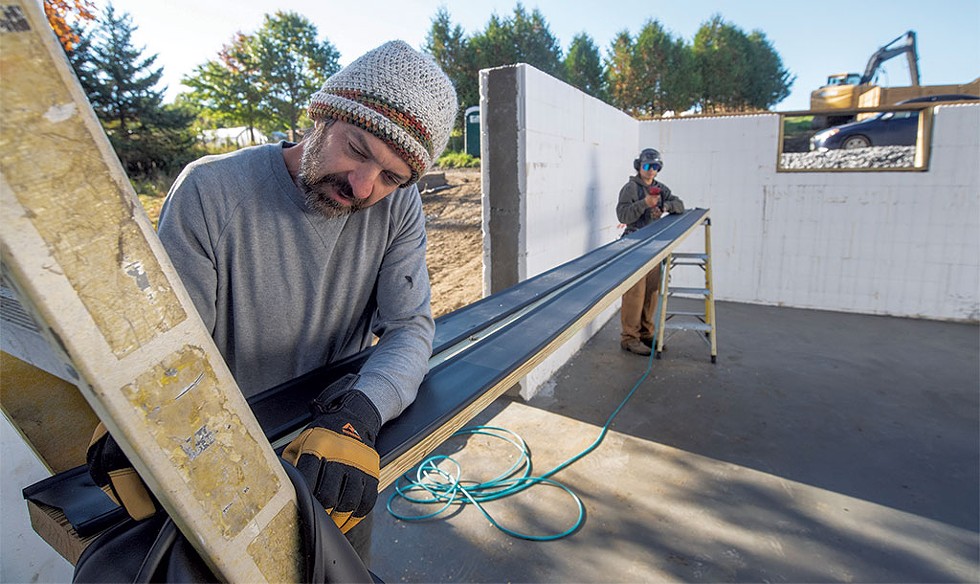

- Jeb Wallace-Brodeur
- Dragan Jakovljevic (left) and Kaden Luster working on a house site in Cabot for Sticks & Stones Construction
Vermont's supply of construction workers never really recovered after the 2008 housing crash that ushered in the Great Recession, according to Matt Musgrave, government affairs director at the Associated General Contractors of Vermont, a trade group. The Associated General Contractors of America has reported that about 17,000 people were working in the construction trades in Vermont in 2000, a number that dropped to about 13,000 by 2010. Many people who left never returned to the field.
These days, Associated General Contractors estimates Vermont's construction workforce stands at about 15,000, a number the trade group would like to see grow by 1,000 annually for the next five years.
The association and its members have spent millions of dollars in the last few years on job fairs, online job boards — including a new site created by the group — and other measures to attract workers, Musgrave said.
These efforts have helped draw about 2,500 people into the construction field this year. But about 2,000 leave Vermont's construction workforce each year through retirements, job changes or moves out of state.
Musgrave said that 500 net gain comes from Vermont's limited pool of young people — and to increase that number, the state has to look elsewhere. "What we need to do is attract some people from outside of the state, as well."
The trades aren't unique; Vermont has an overall workforce deficit — and the housing shortage is often cited as one of the primary reasons it's difficult to attract new residents and workers.
"We could insert almost any category of jobs or skill sets into this conversation," said Betsy Bishop, president of the Vermont Chamber of Commerce. "I hear it everywhere."
The problem is more urgent in the construction industry because billions of dollars in federal COVID-19 emergency funding and infrastructure dollars have flooded Vermont. The money is being used to build roads, fix bridges, create electric vehicle charging stations, bring broadband to rural areas and improve wastewater systems to promote housing growth. All that building requires workers.
Lack of training opportunities is not the primary issue, Bishop said: "The real problem is that we do not have enough people going through the training programs. Therefore, we don't have enough people going into the construction industry."
Seeking greater social and work opportunities, many young people leave Vermont. A recent Washington Post article listed Vermont as the No. 1 state for what it called "brain drain," followed closely by West Virginia and New Hampshire.
The problem is exacerbated by the state's low birth rate. Gov. Phil Scott noted in an interview that Vermont has 30,000 fewer kids in its schools than it did 20 years ago.
"That's 30,000 fewer kids coming into the workforce," he said. "The math is the math."
Workforce growth in the sector is going to be slow, Scott said — and it's going to rely heavily on attracting new working-age people to the state. The Vermont Talent Pipeline, a group of employers and public agencies aiming to align workforce skills with the needs of the economy, puts the average age of a construction worker in Vermont at around 45.
"There comes a time when they're not going to be able to do it anymore, and I don't see enough of our youth coming in," Scott said.
His administration did create a program that invited would-be new residents to visit Vermont to learn about job and housing opportunities, but it stalled during the pandemic. Another state initiative reimburses some moving costs for people who move from out of state to take a job.
However they get to Vermont, newcomers confront the state's housing crisis. If they find a place to live, they're lucky. If they want or need to renovate a home, they're having a tough time getting help.
Locals aren't having much luck with their home projects, either. For example, Wallace, the Marshfield builder, said he's booked out until 2024.
"I want to build a new house next year, and I'm trying to get them to return a phone call," Pat Moulton, director of workforce development for the Vermont State College System, said of her search for a contractor. "They don't have any time, and they can't find the people."
The House That Students Built
click to enlarge 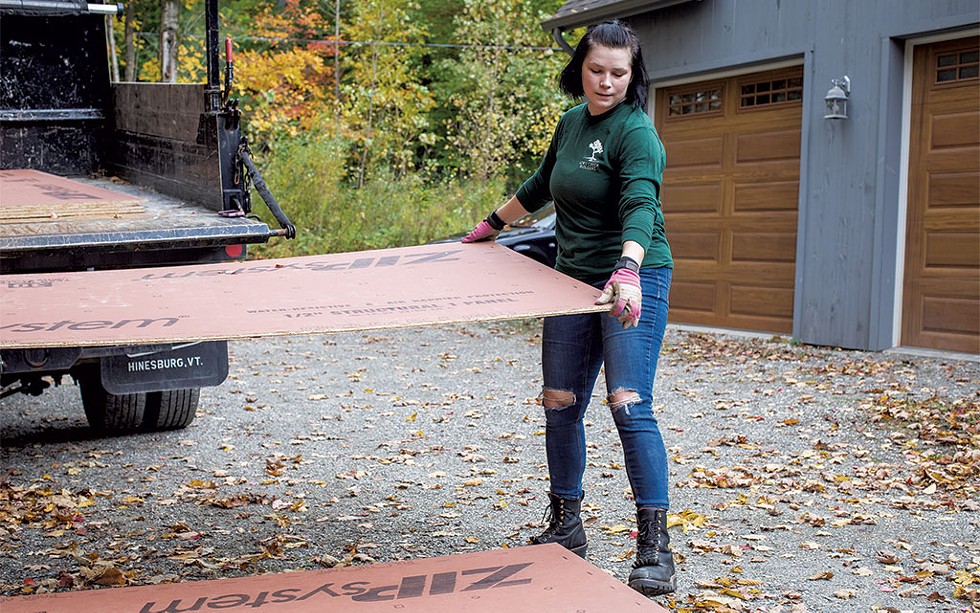

- Luke Awtry
- Lily Lukaszevicz of Lewis Creek Builders unloading materials at a jobsite in Huntington
Chris Welch, a residential building instructor at the Center for Technology in Essex Junction, is building a 2,800-square-foot house from top to bottom with an oversize crew: 28 high school students, way more than a typical jobsite would use.
It's been crowded on the second floor, where students are busy with interior work, but Welch is happy to have so many hands on deck. The number of applicants to the school's building trades program has grown from 20 in 2017 to 58 this year.
Carpenters and others in the building crafts have long learned on the job. But building has become more specialized in recent years, and now formal certifications — particularly those related to safety — are all but required on most jobsites.
They're part of the curriculum at Vermont's 17 school-based career and technical education programs, which serve as regional hubs for school districts. About a third of Vermont's high school students take at least one class at the centers.
Welch thinks students are doing a good job of spreading the word about his home-building class, which is now at work on its 29th house in a development on land owned by Essex High School. The high school kids have been building the homes, which are sold through a real estate agent, since 1976. Nevertheless, area high schools still seem reluctant to encourage students to try the program, he said.
Many schools have a financial disincentive to do so. State education dollars follow students from their home districts to the technical programs they learn in.
"Sometimes there is hesitancy from schools to bring up the idea of tech education because of the funding issue," Welch said.
The Scott administration hopes to change that, and the legislature's Joint Fiscal Office is studying the issue with the hope of producing recommendations in January.
Welch and others who teach in career-technical programs do see signs of hope. Students have paid attention to the well-publicized problems of college debt, and many are determined not to end up owing tens of thousands of dollars for a degree of dubious value.
When Jeremi Lyford, the career development coordinator at Randolph Technical Career Center, talks to students about trying out career-technical training, they don't seem interested in the details, such as whether they'll need additional training post-high school, he said.
"They want to know how much money can be made," Lyford said. "They just want to know what the bottom line is."
The pay for construction work varies. Lyford said one of his students, now a 22-year-old electric utility lineman, made $118,000 last year. The Vermont Department of Labor said the average annual pay for a construction worker last year was $57,000, about 3 percent higher than the average salary in Vermont.
"The trades could really appeal to students if it was laid out for them that 'Hey, you can make a lot of money right off the bat,'" said Lukaszevicz, the former Champlain College student who now works as a carpenter. "You don't have to go through four years of school and hope you get a good job in the field you want. You can dive right into doing it without futzing around."
That's why Champlain Valley Union High School student Spencer Cousino, 17, decided to enter the Essex program. "Financially, it makes the most sense," Cousino said.
Last year, the students started their work on bare land, framing the home. Now, they're inside building walls and completing more detailed interior work.
Cousino, who uses "they" pronouns, said their parents support their decision not to go to college — at least not right away. Cousino likes the sense of independence that comes along with mastering new skills.
"You save so much money by knowing how to do things like this," they said.
ReSOURCING Workers
Increasingly, businesses are ready to provide training. Companies such as VHV build it into the job, letting workers choose a track and paying them to learn. Next month, a half dozen of Vermont's larger home-building companies will start a new weekly construction training program at ReSOURCE, a Burlington nonprofit that provides job training.
The 18-month program was organized by the Vermont Talent Pipeline. It will provide entry-level workers with a type of group apprenticeship that leads to a carpentry certification. The goal is to help participants qualify for higher-skilled positions, said Mary Anne Sheahan, the pipeline's executive director.
"Construction companies have a lot of people retiring in the higher-level positions, and the only way to get to those positions is to go the carpentry route," Sheahan said. "If you have got those skills and you're good at what you do, the career options are great."
The companies in the program are competitors, but the labor crisis has brought them together to find common solutions, said Chet Layman, vice president of South Burlington-based PC Construction, which employs 400 people from Maine to Florida.
He said that while the program won't help companies find new workers, it should help them retain employees by providing them a path toward more responsibility. Retention is as big a problem as finding workers in the first place, he said.
"We hire someone, and they don't show up for the first day," Layman said. "Or they last two days and say, 'This is not for me.'"
Several nonprofit groups also provide free or low-cost job training. In addition to Vermont Works for Women, the Richmond-based Vermont Youth Conservation Corps hires up to 300 young people each year to work on public service projects and learn on the job.
These construction programs also teach communication and basic job readiness, such as dressing appropriately and showing up on time. Wilcox, of the Winooski company VHV, and many others in the construction business said they can't find enough people who understand the commitment that a job demands.
"It seems like most employees' jobs are secondary to what they want to do in life," said Wilcox, who graduated from college in 1976. "It's almost like you have to beg for them to come to work and be there on time and put in a full day."
Culture Shift
click to enlarge 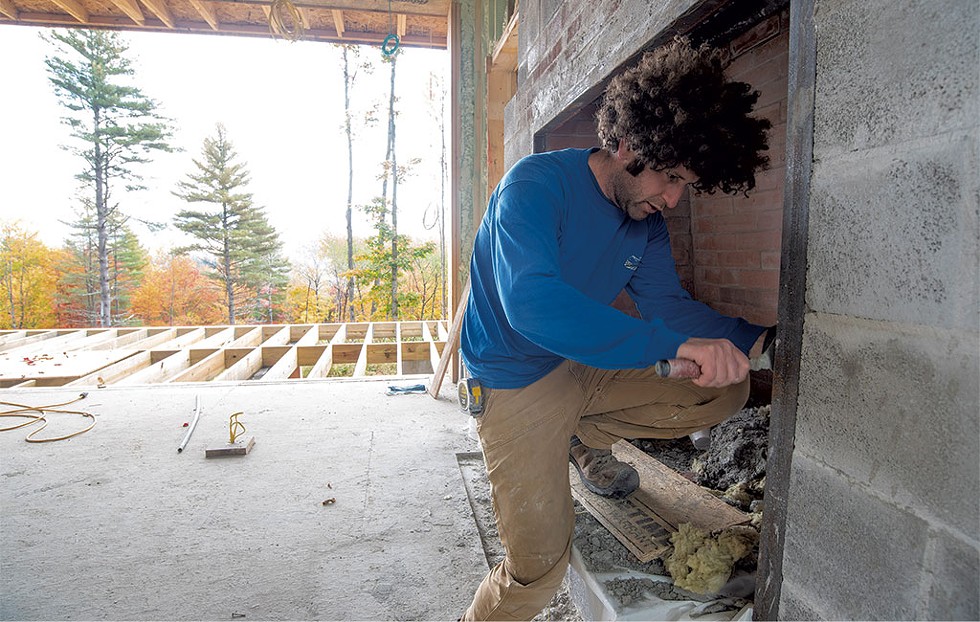

- Jeb Wallace-Brodeur
- Dave Torres working on a fireplace in a new home under construction in Stowe
There's been an explosion of theories about work habits and trends such as the Great Resignation and "quiet quitting" — a term that emerged over the summer to describe the ways in which workers prevent their jobs from becoming a ruinous grind. As the Gallup organization describes it, quiet quitting is meeting the requirements of your job but not going beyond them.
To engage employees who choose not to hustle for advancement, academics and HR managers have been seeking to summarize what workers are looking for, and why.
In the construction business, some managers theorize that young people just aren't as willing as their predecessors to tolerate the physical demands and exposure to the elements that are inevitable on a building site. They also expect to have more time with their families.
"I do believe they have a different work ethic, though maybe it's a better work ethic," said Layman, of PC Construction, who described himself as a "60-plus-hour-a-week person, unfortunately." He graduated from college in 1986.
"Maybe they have a better sense of the balance of life than our generation has," Layman said.
"But we do want them to show up five days a week," he added. "We, the older generation, have to become more educated on what motivates them and try to work that into our methods for our organization."
Similarly, recruiters don't really have a way to reach workers who follow unusual paths to the trades or come and go from the professions.
Dave Torres, for example, worked as a musician for many years before he discovered masonry when he offered to help a friend take apart a chimney in 2006. Something about working with brick and stone had immediate appeal.
"I was giddy," said Torres, 40, who now works year-round for a masonry company in Stowe. His skills are in such demand that Torres gets several calls a week from friends of friends wondering whether he can take some work on the side.
Cultural reasons prevented some people Torres knows from choosing the trades, he said.
"I think it's too blue-collar for most of the people who grew up around here who aren't already in it," Torres said. "They encounter people who are not like them in the field — a personality that can be really abrasive to the very sensitive Gen Z 'Why don't you care about my well-being at work?' kind of person.
"The attitudes," he said, "just don't seem to line up."
Vermont Opens Its Toolbox
Gov. Scott is well aware there's a stigma attached to pursuing vocational education and is actively trying to dispel it. Before his current full-time job, he worked in construction for 35 years. Some of his recent speeches have included anecdotes about his experiences in the machine trades program at Barre's Spaulding High School.
"I can say from my own personal experience that I know it's not always easy to choose the [career-technical] track, even when it's your passion," he said at a press conference over the summer at Green Mountain Technology & Career Center at Lamoille Union High School in Hyde Park.
He's made noncollege career preparation a priority of his administration. Vermont had about 2,000 people in apprenticeships last year, according to the state Department of Labor. Graduates are expected to see their wages rise at twice the state average over the next four years.
This year, the state Department of Labor got an additional $1 million to support its registered apprenticeship programs and will add four new ones — including carpentry — to its roster of more than 200. Employers who sponsor apprentices qualify for tool and equipment reimbursements up to $300.
The Scott administration also plans to use $15 million to create a grant program that would help students at career-technical centers renovate properties in their communities. And the Agency of Education is planning a $1 million publicity campaign showcasing the appeal of the trades.
In an interview, Scott described himself as a hands-on learner who was well suited to the trades. Although he earned a bachelor's degree from the University of Vermont and planned to teach, he soon started working for his uncle's Middlesex excavation company, DuBois Construction. He bought the company with his cousin Don DuBois in 1986 and owned it until he became governor in 2017.
Scott's face brightened when he talked about some of the personal projects he has worked on recently — including a small addition to his home and a tree house for his family's two huskies that he built over the summer using wood left over from the first project. His work as governor, he said, doesn't always offer the tangible sense of accomplishment that building does.
"I can look back and tell you stories about almost each and every project we built, small to large," he said of his construction company. "It's not for everyone, but it's lucrative and it's satisfying."
By the Numbers
$57,000
Average annual pay for a construction worker in Vermont
15,000
Estimated size of Vermont's construction workforce in 2022
5,000
The number of new carpenters needed to meet Vermont's home-building demand in the next 10 years
2,000
Number of workers who leave the construction workforce each year through retirements, job changes or moves out of state
45
Average age of a construction worker in Vermont
Sources: Vermont Department of Labor; Associated General Contractors; Vermont Talent Pipeline
 Seven Days is examining Vermont's housing crisis — and what can be done about it — in our Locked Out series this year. Send tips to [email protected]. These stories are supported by a grant from the nonprofit Journalism Funding Partners, which leverages philanthropy and fundraising to boost local reporting.
Seven Days is examining Vermont's housing crisis — and what can be done about it — in our Locked Out series this year. Send tips to [email protected]. These stories are supported by a grant from the nonprofit Journalism Funding Partners, which leverages philanthropy and fundraising to boost local reporting.
Got something to say?
Send a letter to the editor
and we'll publish your feedback in print!
About The Author

Anne Wallace Allen
Bio:
Anne Wallace Allen covers breaking news and business stories for Seven Days. She was the editor at the Idaho Business Review and a reporter for VTDigger and the Associated Press in Montpelier.
Anne Wallace Allen covers breaking news and business stories for Seven Days. She was the editor at the Idaho Business Review and a reporter for VTDigger and the Associated Press in Montpelier.
More By This Author
Latest in Category
Speaking of...
-

Q&A: Carpenter Dario Guizler Renovates Old Houses and Mentors Fellow Immigrants
Jan 17, 2024 -

A Timber-Frame Company in Starksboro Relies on Human Touch
Jan 16, 2024 -

Video: Carpenter Dario Guizler Builds a Life in Burlington
Jan 11, 2024 -

Vermont Guard Plans to Demolish Winooski Armory, Sell Property
Jan 9, 2024 -

Burlington High School Demolition Slowed by Asbestos
Jul 24, 2023 - More »




























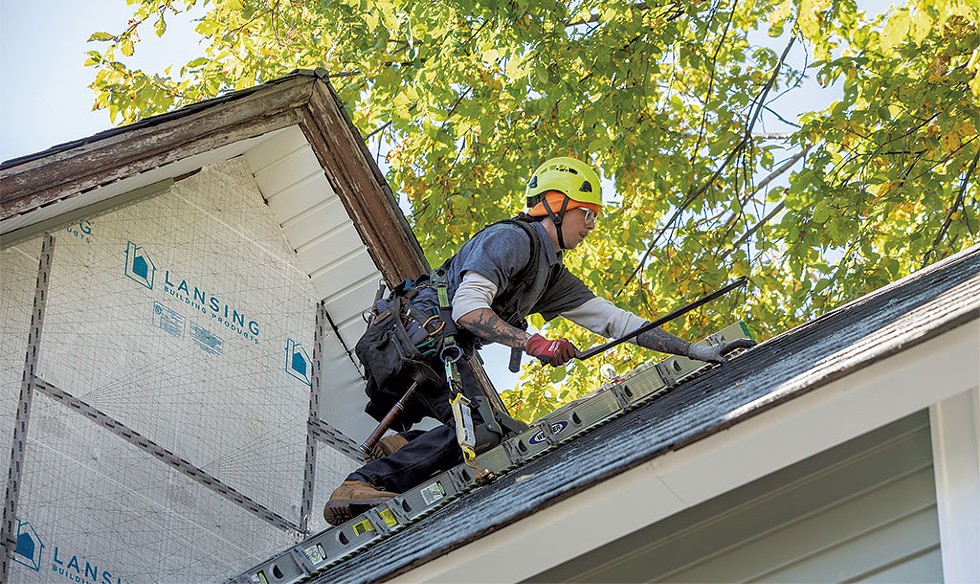
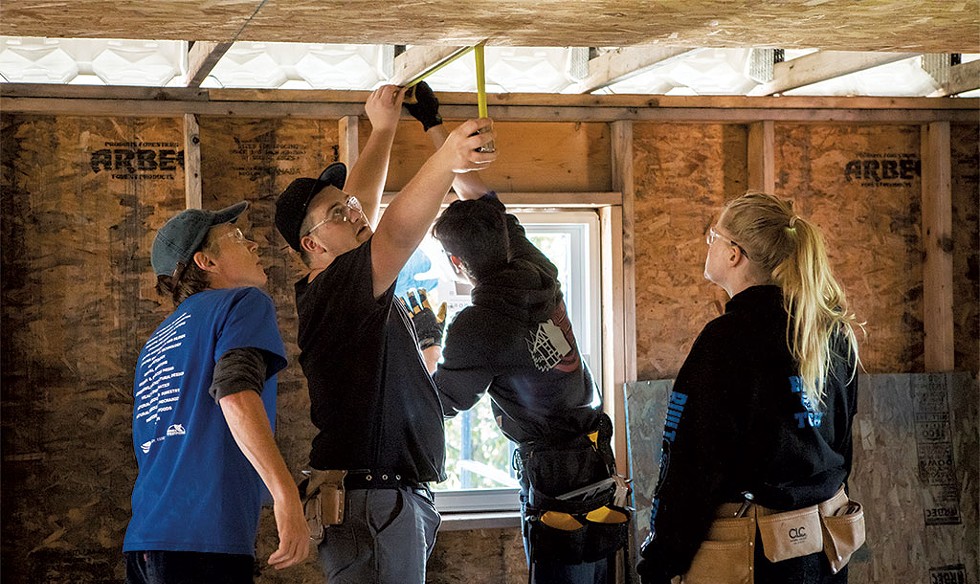















find, follow, fan us: